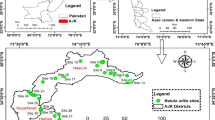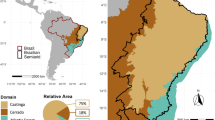Abstract
Detarium microcarpum (Caesalpiniaceae) is a priority, multipurpose, and indigenous food tree species in West Africa. However, data related to its efficient conservation and sustainable use, through changing ecological environments, are still lacking. Thus, species occurrence records were combined with climatic and soil data in Maximum Entropy (Maxent), a species distribution modelling algorithm, to evaluate the impacts of future environmental conditions (under CNRM-CM5 and HadGEM2-ES) on the species’ potential distribution in Benin. Results indicated that the species’ present potential distribution range was mainly found in the Sudanian and Sudano-Guinean ecological regions. Some extensions and retractions of the present-day distribution (lowly, moderately and highly suitable habitats) were noted under future climates based on the two scenarios. Introduction of D. microcarpum in suitable habitats are required for its efficient conservation in West Africa.






Similar content being viewed by others
References
Adjahossou SGC, Gouwakinnou GN, Houéhanou DT, Sode AI, Yaoitcha AS, Houinato MRB, Sinsin B (2016) Efficacité des aires protégées dans la conservation d’habitats favorables prioritaires de ligneux de valeur au Bénin. Bois Forêts Trop 2:67–76
Adomou CA (2005) Vegetation Patterns and Environmental gradients in Benin. Implications for biogeography and conservation, Ph.D. Thesis. Wageningen University, Wageningen
Agbo RI, Missihoun AA, Vihotogbé R, Assogbadjo EA, Ahanhanzo C, Agbangla C (2017) Impacts des usages traditionnels sur la vulnérabilité de Detarium microcarpum Guill. & Perr. (Caesalpiniaceae) dans le district phytogéographique Zou au Bénin (en Afrique de l’Ouest). Int J Biol Chem Sci 11:730–743
Agbo IR, Vihotogbé R, Missihoun AA, Dagba RA, Assogbadjo EA, Ahanhanzo C, Agbangla C (2018) Traditional uses of Detarium microcarpum Guill. & Perr. (Caesalpiniaceae) and priorities for conservation in Benin (West Africa). Environ Dev Sustain (submitted)
Akouèhou GS, Goussanou CA, Idohou R, Dissou FE, Azokpota P (2014) Importance socioculturelle de Artocarpus altilis (Parkinson) Fosberg (Moraceae) au Sud-Bénin. J Appl Biosci 75:6173–6182
Assogbadjo AE, Idohou R, Chadare FJ, Salako KV, Djagoun CAMS, Akouèhou G, Mbairamadji J (2017) Diversity and prioritization of non-timber forest products for economic valuation in Benin (West Africa). Afr J R Dev 2:105–115
Ayihouénou EB, Fandohan B, Sodé AI, Gouwakinnou NG, Djossa AB (2016) Biogéographie du néré (Parkia biglobosa (Jack.) R. Br. ex. Don.) sous les conditions environnementales actuelles et futures au Bénin. Bulletin de la Recherche Agronomique du Bénin. Numéro spécial Agronomie, Société, Environnement & Sécurité Alimentaire p 93–108. http://www.slire.net
Bourou S (2012) Étude éco-physiologique du tamarinier (Tamarindus indica L.) en milieu tropical aride, Thèse de Doctorat (PhD), Faculté des Sciences en Bio-Ingénieries, Université de Gand, Belgique. ISBN: 978-90-5989-509-6
Bowe C (2007) Predicting suitable areas for the production of tamarind (Tamarindus indica L.) an underutilized fruit tree species, Ph.D. Thesis. University of Southampton, Southampton
Bowe C, Haq N (2010) Quantifying the global environmental niche of an underutilized tropical fruit tree (Tamarindus indica) using herbarium records. Agr Ecosyst Environ 139:51–58
Busby JW, Smith TG, White KL, Strange SM (2010) Locating climate insecurity: where are the most vulnerable places in Africa? Austin, TX. In: University of Texas, The Robert Strauss Center for International Security and Law, Climate Change and African Political Stability. CCAPS, Austin
Castro AJ, Martín-Lopez B, Lopez E, Plieninger T, Alcaraz-Segura D, Vaughn C, Cabello J (2015) Do protected areas networks ensure the supply of ecosystem services? Spatial patterns of two nature reserve systems in semi-arid Spain. Appl Geogr 60:1–9. https://doi.org/10.1016/j.apgeog.2015.02.012
Cavin AL (2007) Contribution à la connaissance taxonomique et chimique de fruits africains du genre “Detarium” (Fabaceae—Caesalpinioideae): “D. microcarpum” Guill. et Perr. et des formes comestibles et toxiques de “D. senegalense”. J.F. Gmel Thèse de doctorat: Univ. Genève, No. Sc. 3838
Cernansky R (2015) Africa’s indigenous fruit trees a blessing in decline. Environ Health Perspect 123(12):291–296. https://doi.org/10.1289/ehp.123-A291
Coudun C, Gégout JC, Piedallu C, Rameau JC (2006) Soil nutritional factors improve models of plant species distribution: an illustration with Acer campestre (L.) in France. J Biogeogr 33(10):1750–1763
do-Régo ME (2017) Etude écogéographique, modélisation des habitats suitables et gap de conservation de 15 espèces des parents sauvages des plantes cultivées prioritaires pour la conservation au Bénin. Mémoire de Master. Département d’aménagement et gestion de l’environnement/FSA/UAC
Elith J, Kearney M, Phillips S (2010) The art of modeling range shifting species. Methods Ecol Evol 1:330–342
Environmental Systems Research Institute, ESRI, Inc (2014) ArcGIS software. ESRI, Redlands
Fandohan B, Assogbadjo AE, Glèlè Kakaï RL, Sinsin B (2010) Effectiveness of a protected areas network in the conservation of Tamarindus indica (Leguminosae Caesalpinioideae) in Benin. Afr J Ecol 49:40–50
Fandohan B, Gouwakinnou GN, Fonton NH, Sinsin B, Liu J (2013) Impact des changements climatiques sur la répartition géographique des aires suitables à la culture et à la conservation des fruitiers sous-utilisés: cas du Tamarinier au Bénin. Biotechnol Agron Soc Environ 17:450–462
FAO/IIASA/ISRIC/ISSCAS/JRC (2012) Harmonized World Soil Database (version 1.2). FAO, Rome
Fielding AH, Bell JF (1997) A review of methods for the assessment of prediction errors in conservation presence/absence models. Environ Conserv 24:38–49
Goussanou C, Tenté B, Djègo J, Agbani P, Sinsin B (2011) Inventaire, caractérisation et mode de gestion de quelques produits forestiers non ligneux du Bassin versant de la Donga. Ann Sci Agron 14:77–99
Gouwakinnou GN (2013) Using niche modelling to plan conservation of an indigenous tree species under changing climate: example of Sclerocarya birrea in Benin, West Africa. Res Dev Sub-Saharan Afr 5:1–8
Heywood VH (2008) Challenges of in situ conservation of crop wild relatives. Turk J Bot 32:421–432
Houinato M, Sinsin B, Lejoly J (2001) Impact des feux de brousse sur la dynamique des communautés végétales dans la forêt de Bassila (Bénin). Acta Bot Gall 148:237–251
Idohou R, Assogbadjo AE, Glèlè Kakaï R, Peterson AT (2017) Spatio-temporal dynamic of suitable areas for species conservation in West Africa: eight economically important wild palms under present and future climates. Agroforest Syst 91:527–540
Ilmen R, Benjelloun H (2013) Les écosystèmes forestiers marocains à l’épreuve des changements climatiques. Forêt méditerranéenne XXXIV 3:195–208
IPCC (2007) Climate change: synthesis report. Cambridge University Press, New York
Kouyaté AM, Lamien N (2011) Detarium microcarpum, sweet detar. Conservation and sustainable use of genetic resources of priority food tree species in sub-Saharan Africa. Bioversity International, Rome
Kouyaté AM, van Damme P (2006) Detarium microcarpum Guill. & Perr. [online]. Record from Protabase. In: Schmelzer GH, Gurib-Fakim A (eds) PROTA (Plant Resources of Tropical Africa/Ressources végétales de l’Afrique tropicale), Wageningen, The Netherlands. Available at: http://database.prota.org/search.htm. Consulté le 25 Sept 2014
Leakey RRB (2010) Should we be growing more trees on farms to enhance the sustainability of agriculture and increase resilience to climate change? Special Report. International Society of Tropical Foresters News, United States Agency for International Development, Maryland
Linder HP, Lovett J, Mutke JM, Barthlott W, Jürgens N, Rebelo T, Küper W (2005) A numerical re-evaluation of the sub-Saharan phytochoria of mainland Africa. Biol Skr 55:229–252
Luque S, Vainikainen N (2008) Habitat quality assessment and modelling for biodiversity sustainability at the forest landscape level. In: Lafortezza R, Chen J, Sanes IG, Crow T (eds) Patterns and processes in forest landscapes: multiples use and sustainable Management, Part III Landscape-Scale indicators and projection models. Springer, Berlin
Marshall AR, Platts PJ, Gereau RE, Kindeketa W, Kang’ethe S, Marchant R (2012) The genus Acacia (Fabaceae) in East Africa: distribution, diversity and the protected area network. Plant Ecol Evol 145:289–301
Nagel P, Sinsin B, Peveling R (2003) Conservation of biodiversity in a relic forest in Benin−an overview. Regio Basiliensis 45(2):125–137
Norris K, Asase A, Collen B, Gockowksi J, Mason J, Phalan B, Wade A (2010) Biodiversity in a forest-agrimosaic—the changing face of West African rainforests. Biol Conserv 143:2341–2350
Padonou AE, Teka O, Bachmann Y, Schmidt M, Lykke AM, Sinsin B (2015) Using species distribution models to select species resistant to climate change for ecological restoration of bowé in West Africa. Afr J Ecol 53:83–92
Pearson RG (2007) Species’ distribution modeling for conservation educators and practitioners: synthesis american museum of natural history. http://ncep.amnh.org
Peterson AT, Papes M, Soberon J (2008) Rethinking receiver operating characteristic analysis applications in ecological niche modelling. Ecol Model 213:63–72
Peterson AT, Soberon J, Pearson RG, Anderson RP, Martinez-Meyer E, Nakamura M, Araujo MB (2011) Ecological niches and geographic distributions. Princeton University Press, Princeton
Phillips SJ, Anderson RP, Schapire RE (2006) Maximum entropy modeling of species geographic distributions. Ecol Model 190:231–259
Saupe EE, Barve V, Myers CE, Sobero´n J, Barve N, Hensz CM, Lira-Noriega A (2012) Variation in niche and distribution model performance: the need for a priori assessment of key causal factors. Ecol Model 237:11–22
Sodé I (2013) Influence du changement climatique sur la distribution géographique des fruitiers autochtones alimentaires: cas de Dialium guineense Willd. (Leguminosae-Caesalpinioideae) au Bénin. Mémoire de Licence Professionnelle, Université d’Abomey-Calavi, ENSAT/Kétou, p 71
Termote C, Van Damme P, Dhed’a Djailo B (2010) Eating from the wild: Turumbu, Mbole and Bali traditional knowledge on non-cultivated edible plants, District Tshopo, DR Congo. Ecol Food Nutr 49:173–207
Van Zonneveld M, Koskela J, Vinceti B, Jarvis A (2009) Impact of climate change on the distribution of tropical pines in Southeast Asia. Unasylva 232:24–29
Warren DL, Glor RE, Turelli M (2010) ENMTools: a toolbox for comparative studies of environmental niche models. Ecography 33:607–611
Wembou PE, Atakpama W, Fandohan B, Tozo K, Akpagana K (2017) Incidences des facteurs bioclimatiques sur la distribution et la conservation de Dioscorea praehensilis Benth dans la zone subhumide du Togo. Can J Trop Geol 4:59–68
World Agroforestry Centre (2008) Transforming lives and landscapes. Strategy 2008–2015. World Agroforestry Centre, Nairobi
Acknowledgements
The authors declare their gratitude to the Ministry of Higher Education and Scientific Research (MESRS) of the Republic of Benin for having awarded the scholarship for this work, which is part of a thesis project of Doctorate for the first author. Acknowledgments are also extended to the members of the Village Association for the Management of Forest Resources (AVIGREF) of the different classified and sacred prospected forests, to the sirs Aimé Malo DJESSOU and Brice AHOUANSOMBO BADE for their contributions. They also thank the Colleagues of the Laboratory of Biomathematics and Forestry Estimations (LABEF) of the University of Abomey-Calavi, in particular Mr Eunock do-REGO and Mrs Donalde DEGUENON.
Author information
Authors and Affiliations
Corresponding author
Ethics declarations
Conflict of interest
The authors declare that they have no competing interests in this manuscript.
Rights and permissions
About this article
Cite this article
Agbo, R.I., Idohou, R., Vihotogbé, R. et al. Spatio-temporal dynamics of suitable habitats for Detarium microcarpum Guill. & Perr. (Caesalpiniaceae), a priority food tree species in Benin (West Africa). Model. Earth Syst. Environ. 5, 595–604 (2019). https://doi.org/10.1007/s40808-018-0550-x
Received:
Accepted:
Published:
Issue Date:
DOI: https://doi.org/10.1007/s40808-018-0550-x




